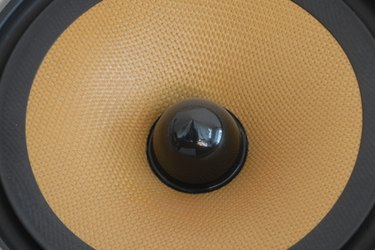
A woofer is a type of speaker designed to reproduce low- to mid-range frequency sounds. A subwoofer is designed to reproduce the lowest sound frequencies and will typically reproduce sounds ranging from 20 hertz to 200 hertz. They consist of a cone, as do most speakers, that ranges in diameter from 8 inches to 21 inches. Subwoofers move a lot of air in order to reproduce these low frequencies, which often contributes to the "feel" of the sound being reproduced.
Cone Seal Failure
Video of the Day
In order to produce sound, all woofers, including subwoofers, need to be able to move air at an accurate frequency. They do this by moving the speaker cone back and forth, pushing and puling air. The cone is sealed to the enclosure by any one of various materials. If this seal is broken, the speaker cone moves, but cannot properly move the air into the space for which it's intended. Instead, the air moves around the cone edges back and forth into the enclosure. Additionally, the resistance of the speaker also diminishes because the seal is no longer providing correct resistance. This allows the speaker to move too much and too fast, sometimes resulting in collisions with other parts of the system.
Video of the Day
Driver Magnet Failure
All woofers, including subwoofers, consist of a cone attached to a permanent magnet, not an electromagnet. The magnet is at the bottom of the cone and rests near a coil of wire that can act as an electromagnet. As signals from a source provide voltage and current to the electromagnet, the electromagnet repels or attracts the permanent magnet, therefore driving the cone and producing sound. If the permanent magnet were to break for some reason, the number of magnet poles interacting with the electromagnet would change as well, making it unable to reproduce sound correctly or sometimes even at all.
Short Circuit
The most common cause of speaker failure is short-circuiting. A short circuit in the wires providing the signal will prevent the signal from ever reaching the subwoofer. A short circuit at the terminals on the subwoofer will also prevent electrical current and signal from reaching the subwoofer. Finally, a short circuit in the coil will drastically reduce the amount of power that can be produced by the electromagnet, and may not even leave enough power to drive the cone.
Lack of Power
If there is not enough amperage reaching the electromagnetic coil in the subwoofer, there will not be enough strength in the resulting electromagnetic field to interact successfully with the permanent magnet.